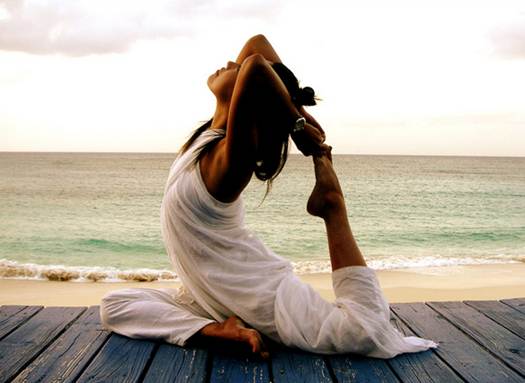Stress is so finely woven into everyday
life that it’s hard to imagine a day without it. Whether it’s work, family,
deadlines or money, there always seems to be something to worry about. But even
if you’re well accustomed to the feeling of stress, it can take a mental and
physical toll on your wellbeing.

The
fact that we very rarely stop and take time to just “be”, even for a few
minutes, goes against our true human nature
In fact, according to mental health charity
Mind, you may have some of the physical symptoms of stress without even being
aware of it. Breathlessness, feeling sick or dizzy, restlessness, sleeping
problems, food cravings, constipation or diarrhea can all point to a heavy
stress load, while severe stress has been linked to heart disease.
The science of calm
No wonder that scientists are now focusing
on the best ways to beat stress and improve wellbeing. But while yoga has been
steadily gaining popularity in the western world, the scientific community is
only just catching up to what yogis have long known: that the ancient practice
of yoga can have a significant impact on mental wellbeing and emotional and
physical strength. The word yoga means “union” in Sanskirt (the language of
ancient India where yoga began) and the postures are designed to coordinate the
breath, mind and body to encourage internal and external balance, and boost
relaxation.
Back in 2005 a German study found that
taking two 90-minute yoga classes a week for three months improved levels of
depression by 50 per cent and anxiety by 30 per cent in women who described
themselves as “emotionally distressed”. And in a recent UK study, British
university staff who showed stress and concern for their emotional wellbeing
were sent to 60-minute yoga class once a week for six weeks. The staff reported
a significant improvement in feelings of elation, energy, composure and
confidence, as well as a renewed sense of life purpose.

The
most important thing is to find the mindfulness method that works best for you
Time to slow down
Yoga might sound like the ideal antidote to
life’s relentless rat in theory, but who has the time for 60 minutes of
downward dogs when there are deadlines to meet? It’s an argument yoga expert
Conrad Paul, founder of www.yogaprofessionals.net,
hears a lot.
“Most people feel there are not enough
hours in the day to do what they think they should be doing,” he says. “But,
the fact that we very rarely stop and take time to just “be”, even for a few
minutes, goes against our true human nature and is often detrimental to our
health, as the body and mind get no time to stop.”
The good news is, regular yoga practice,
with its deep connection to meditation, can teach you how to slow down and live
in the moment. Lodro Rinzler, author of The Buddha Walks into a Bar: A Guide to
Life for a New Generation ($19.5, Shambala Publications) says mindfulness is
crucial for modern life. “All too often we rush through our life without any
real appreciation for what’s going on right now,” he says. “Through meditation,
we learn to rest with our current situation: the physical sensation of our
stiff back, our body breathing naturally, and the thoughts flowing through our
mind. This training in being present with various aspects of our life leads to
a sense of slowing down and gaining precision.”
Stress, busted
Hands up if it’s been so long since you
truly relaxed that you’ve forgotten how to connect with yourself? Here’s a tip
– true quality time doesn’t mean sitting in front of the TV, spending hours on
Facebook or reading a book. Instead, we’re talking about taking the time to sit
with your own thoughts and just “be”. And you don’t need to meditate for an
hour to feel the positive effects of this state of mind – just five or 10
minutes, even on your commute to work, can transform your day.
Alternatively, try setting your alarm 10
minutes earlier and practising a few yoga poses and some deep breathing first
thing in the morning. You’ll soon start to see the benefits as practice helps
to boost the feel-good chemicals in your brain, strengthens your immune system
and increases your energy levels. Turn to page 50 for a great flow yoga routine
or try a DVD such as Barbara Currie’s Power of Yoga ($16.5, www.barbaracurrieyoga.com), which
features 10-minute workouts that slot easily into a busy schedule. Yoga is also
a great complementary training technique for runners and cyclists, so working a
weekly class into your regular fitness routine will have real body benefits,
too.
The most important thing is to find the
mindfulness method that works best for you. If you don’t like the first one you
try, don’t be put off. Put it at the top of your to-do list and find out what a
life without stress is really like.
Get started
Try Conrad Paul’s breathing technique to
reconnect to your body and mind. “Observe the gentle inhalation and exhalation
of your breath while imagining the air filling every part of the body down to
the tiniest cell. When you focus on breathing and begin to slow it down, you
are tapping into your subconscious mind and consciously taking control of your
breath.”